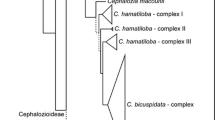Abstract.
Phylogenetic relationships in Rosaceae were studied using parsimony analysis of nucleotide sequence data from two regions of the chloroplast genome, the matK gene and the trnL-trnF region. As in a previously published phylogeny of Rosaceae based upon rbcL sequences, monophyletic groups were resolved that correspond, with some modifications, to subfamilies Maloideae and Rosoideae, but Spiraeoideae were polyphyletic. Three main lineages appear to have diverged early in the evolution of the family: 1) Rosoideae sensu stricto, including taxa with a base chromosome number of 7 (occasionally 8); 2) actinorhizal Rosaceae, a group of taxa that engage in symbiotic nitrogen fixation; and 3) the rest of the family. The spiraeoid genus Gillenia, not included in the rbcL study, was strongly supported as the sister taxon to Maloideae sensu lato. A New World origin of Maloideae is suggested. The position of the economically important genus Prunus and the status of subfamily Amygdaloideae remain unresolved.
Similar content being viewed by others
Author information
Authors and Affiliations
Additional information
Received February 27, 2001 Accepted October 11, 2001
Rights and permissions
About this article
Cite this article
Potter, D., Gao, F., Bortiri, P. et al. Phylogenetic relationships in Rosaceae inferred from chloroplast matK and trnL-trnF nucleotide sequence data. Plant Syst. Evol. 231, 77–89 (2002). https://doi.org/10.1007/s006060200012
Issue Date:
DOI: https://doi.org/10.1007/s006060200012




